26 & 27 January 2021 Current Affairs for UPSC IAS Exam
Contents
- Inequality Virus Report by Oxfam
- Recovery of Labour markets post-lockdown
- ‘Green tax’ mooted for old vehicles
- Decriminalization recommended under LLP Act
- Indian and Chinese troops clash at Naku La pass
INEQUALITY VIRUS REPORT BY OXFAM
Context:
Indian billionaires increased their wealth by 35% during the lockdown, ranking India after U.S., China, Germany, Russia and France according to Oxfam’s ‘Inequality Virus Report’ released on the opening day of the World Economic Forum in Davos.
The report states that Covid has the potential to increase economic inequality in almost every country at once – the first time this has happened since records began over a century ago.
Relevance:
GS-III: Indian Economy (Economic Development in India and Issues related to Economic Development)
Dimensions of the Article:
- Introduction
- Highlights of Oxfam’s report on Impact of Covid Lockdown
- India: extreme inequality in numbers (Pre-Covid)
Introduction
Economy was brought to a standstill after India introduced one of the earliest and most stringent lockdowns to control the spread of Covid-19 and this lockdown triggered largescale aggravation of issues such as unemployment, hunger, distress migration and untold hardship in its wake.
The rich were able to escape the pandemic’s worst impact as the white-collar workers isolated themselves and worked from home whereas a majority of unfortunate labourers lost their livelihood.
Highlights of Oxfam’s report on Impact of Covid Lockdown
- Wealth Inequality: The wealth of Indian billionaires increased by 35% during the lockdown and by 90% since 2009.
- Unemployment: India’s large informal workforce was the worst hit as it made up 75% of the 122 million jobs lost.
- Digital Divide and Education: As Education shifted during the lockdown, just 3% of the poorest 20% of Indian households had access to a computer and just 9% had access to the internet – showing the digital divide worsening inequalities.
- Disruption of Education: It noted that the long disruption of schooling risked doubling the rate of out of school, especially among the poor.
- Sanitation Facility: Only 6% of the poorest 20% households had access to non-shared sources of improved sanitation, compared to 93% of the top 20% households in India. In terms of caste, just 37.2% of Scheduled Castes (SCs) households and 25.9% of Scheduled Tribes (STs) households had access to non-shared sanitation facilities, compared to 65.7% for the general population.
- Gender Disparities in Employment: The unemployment rate among women rose from already high 15% before Covid to 18%. This increase in unemployment of women can result in a loss to India’s Gross Domestic Product (GDP) of about 8% or USD 218 billion. Of the women who retained their jobs, as many 83% were subjected to a cut in income according to a survey .
- Women Health issues: It is predicted that the closure of family planning services will result in 2.95 million unintended pregnancies, 1.80 million abortions (including 1.04 million unsafe abortions) and 2,165 maternal deaths.
- Domestic Violence: As of November 2020, cases of domestic violence rose by almost 60% over the past 12 months, showing that the pandemic also fueled domestic violence against women.
India: extreme inequality in numbers (Pre-Covid)
- The top 10% of the Indian population holds 77% of the total national wealth.
- 73% of the wealth generated in 2017 went to the richest 1%, while 67 million Indians who comprise the poorest half of the population saw only a 1% increase in their wealth.
- Billionaires’ fortunes increased by almost 10 times over a decade and their total wealth is higher than the entire Union budget of India for the fiscal year 2018-19.
- Many ordinary Indians are not able to access the health care they need. 63 million of them are pushed into poverty because of healthcare costs every year – almost two people every second.

-Source: The Hindu
RECOVERY OF LABOUR MARKETS POST-LOCKDOWN
Context:
The National Statistical Office (NSO) expects the Indian Economy’s GDP Contraction to be 7.7% in 2020-21.
This GDP Contraction is a result of the Lockdown imposed in response to the spread of Covid-19, and this lockdown resulted in the aggregate Work Participation Rate, or WPR (individuals employed as a proportion of the working age population) taking a sharp dive.
Relevance:
GS-III: Indian Economy (Issues related to Employment in Indian Economy)
Dimensions of the Article:
- Definitions to know
- Impact of lockdown on Work Participation Rate (WPR)
- Progress in the employment scene BEFORE THE COVID LOCKDOWN
- About Periodic Labour Force Survey (PLFS)
Definitions to know
Work Participation Rate (WPR): WPR is defined as the percentage of total workers to the total population.
Labour Force Participation Rate (LFPR): LFPR is defined as the percentage of persons in labour force (i.e. working or seeking or available for work) in the population.
Unemployment Rate (UR): UR is defined as the percentage of persons unemployed among the persons in the labour force.
Impact of lockdown on Work Participation Rate (WPR)
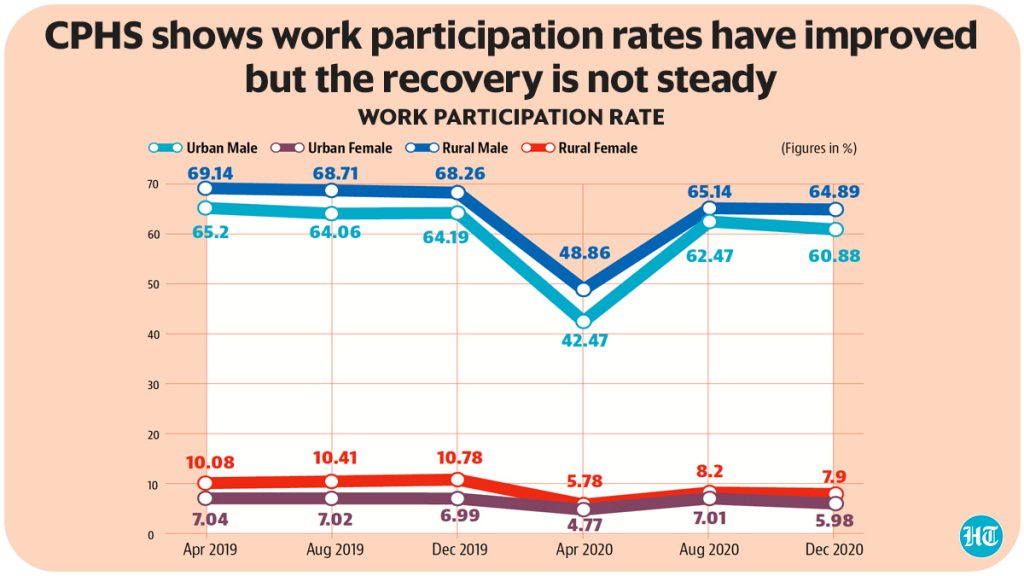
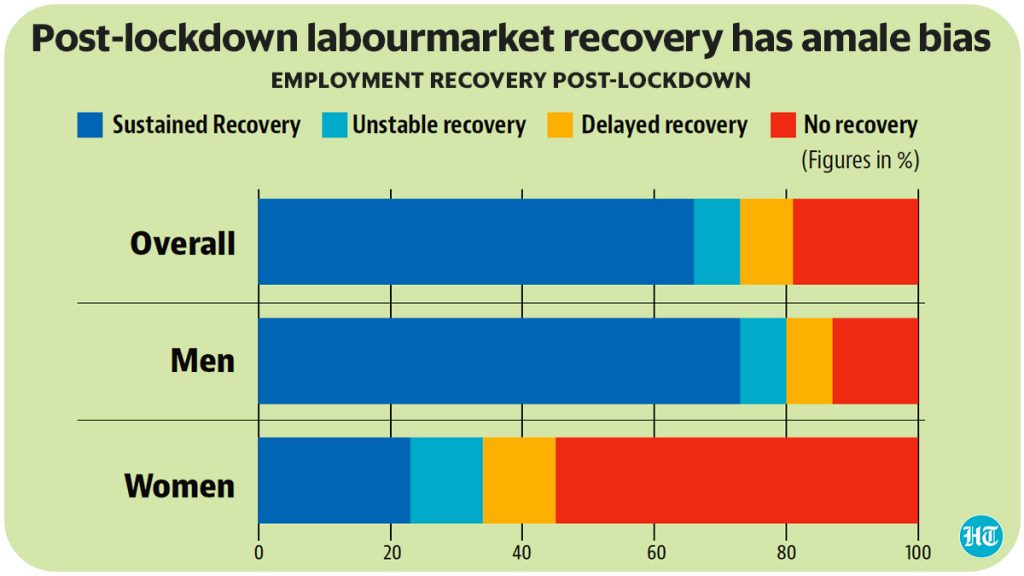
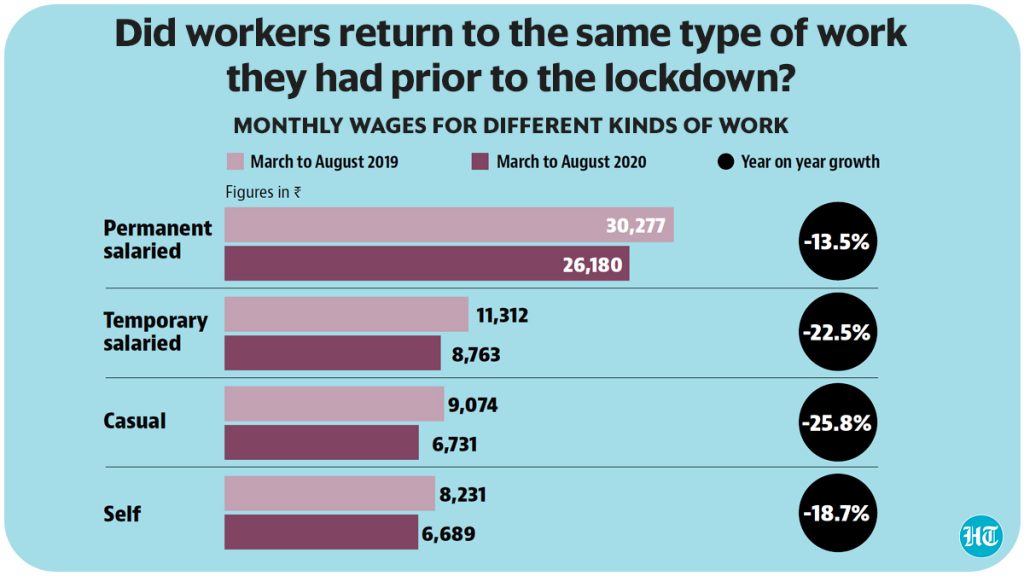
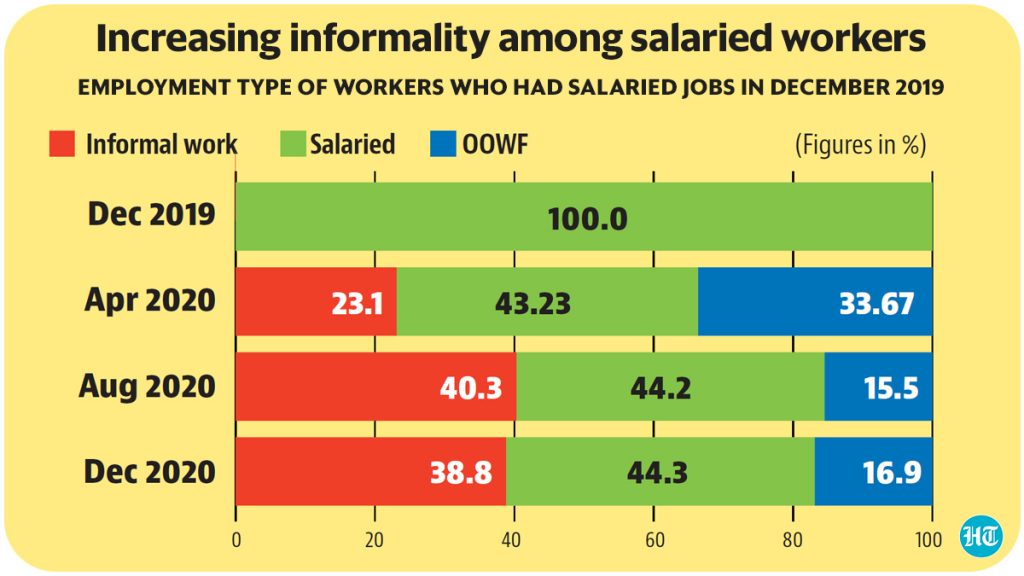
- WPR has subsequently failed to improve and declined slightly in December even though it bounced back to 90% of its pre-lockdown level by August 2020.
- Particularly for women, the recovery has been slow and unsteady.
- In December 2020, WPR for women in urban areas was 85% of its pre-pandemic value. For rural areas, this was even lower at 78%.
- The current WPR implies at least 11 million fewer jobs in the Indian economy in December 2020 compared to December 2019.
- In April 2020, 35% of men who were working in December 2019 lost their jobs. The corresponding proportion for women was twice that, at 70%.
- The pattern of recovery varied greatly between men and women – Not only were fewer women compared to men likely to return and remain in employment, women were also more likely to experience an unstable recovery.
- In April 2020, during the lockdown, 34% of workers in salaried employment lost their jobs and only 43% were able to remain in salaried work with the remaining (23%) moving into informality, either in casual or self employment.
Progress in the employment scene BEFORE THE COVID LOCKDOWN: Periodic Labour Force Survey (PLFS) 2018-19 data
- India’s unemployment rate fell to 5.8% during 2018-19 from 6.1% during the same period of 2017-18.
- The urban unemployment rate reduced from 7.8% to 7.7%. The rural unemployment reduced from 5.3% to 5%.
- The labour force participation rate rose to 37.5% during 2018-19 from 36.9% of 2017-18.
- The female participation rate also improved going up to 18.6% in 2018-19 from 17.5% the year before.
About Periodic Labour Force Survey (PLFS)
- PLFS is India’s first computer-based survey launched by the National Statistical Office (NSO) in 2017.
- It has been constituted based on the recommendation of a committee headed by Amitabh Kundu.
PLFS has two-fold objective:
- To estimate the key employment and unemployment indicators (viz. Worker Population Ratio, Labour Force Participation Rate, Unemployment Rate) in the short time interval of three months for the urban areas only in the Current Weekly Status (CWS).
- To estimate employment and unemployment indicators in both usual status and CWS in both rural and urban areas annually.
Before PLFS, the NSSO (previous name of NSO) used to bring the data related to employment and unemployment based on its quinquennial (every 5 year) household socio-economic survey programme.
-Source: Hindustan Times
‘GREEN TAX’ MOOTED FOR OLD VEHICLES
Context:
The Union Minister for Road Transport and Highways has approved a proposal to levy a ‘green tax’ on old vehicles.
Owners of old vehicles will have to pay the government a ‘green’ tax as a penalty for polluting the environment, which will be much steeper if you reside in one of the more polluted cities in India.
Relevance:
GS-III: Environment and Ecology (Steps for Pollution Control, Conservation of the Environment), GS-II Governance (Government Interventions)
Dimensions of the Article:
- What is Green Tax?
- What is India’s Green Tax on Vehicles?
- What is the need for Green Tax?
- Why Green Tax on Vehicles?
What is Green Tax?
In general, a green tax is imposed on the environment polluting goods or activities, to discourage people from anti-ecological behaviour and make them sensitive towards the environment.
What is India’s Green Tax on Vehicles?
- A green tax imposition in India is a recent development, and different vehicles are being monitored for emissions, especially at state border areas.
- An ECC (Environmental compensation charge) is imposed on different vehicles, both personal and commercial, depending upon their size.
- The green tax varies from state to state. For instance, in Maharashtra, private vehicles that are more than 15 years old or more and commercial vehicles aged 8 years or more are liable to pay the tax.
- Personal vehicles will be charged a tax at the time of renewal of Registration Certification after 15 years.
More about the Latest Proposal
- The proposal on green tax also includes steeper penalty of up to 50% of road tax for older vehicles registered in some of the highly polluted cities in the country.
- The levy may differ depending on fuel (petrol/diesel) and type of vehicle. The proposal will now go to the States for consultation before it is formally notified.
- It includes 10-25% of road tax on transport vehicles older than eight years at the time of renewal of fitness certificate.
- The proposal on green tax also includes steeper penalty of up to 50% of road tax for older vehicles registered in some of the highly polluted cities in the country.
What is the need for Green Tax?
Last decade or so has seen a massive increase in pollution levels all over the world and every country is facing the adverse effects of pollution.
When a manufacturer produces a pollution-causing product, it is not the seller or manufacturer only that bears the brunt of this; everyone faces the adverse effects of pollution.
The following effects of Green Tax make it a necessity to reduce pollution:
- Discourages Pollution-Causing Activities: By levying a duty, it is like a fine or punishment that either the seller or buyer or both have to bear for indulging into pollution-causing activities.
- Encourages “Greener” Projects: Since the duty will make these products more expensive, it encourages other industries, which follow “Green” production practices, to compete and get an edge.
- Collect Funds for Environmental Initiatives: Every country is spending billions of dollars on initiatives that can help in curbing the pollution in future. From forestation projects to river cleaning initiatives, all of these cost in millions and billions to the exchequer. The funds collected from this tax can be used to fund these initiatives making them financially viable.
Why Green Tax on Vehicles?
- As automobile technology tends to change every 10-15 years, older vehicles fail to match the upgraded pollution standards and hence are more polluting than newer vehicles.
- It encourages people to upgrade to newer vehicles rather than spending huge amounts on maintaining the longevity of their current vehicles.
- Also, the number of older vehicles on the roads might decrease thereby reducing pollution.
-Source: Indian Express
DECRIMINALIZATION UNDER LIMITED LIABILITY PARTNERSHIP (LLP) ACT
Context:
In what could be major relief for small and medium businesses in India, the Government proposes to decriminalise the compoundable offences under the Limited Liability Partnership Act 2008.
Relevance:
GS-III: Indian Economy (Economic Development), GS-II: Polity and Governance (Government Policies and Acts)
Dimensions of the Article:
- What is a Limited Liability Partnership (LLP)?
- About the Company Law Committee
- Key points of the Company Law Committee’s (CLC’s) Recommendations
What is a Limited Liability Partnership (LLP)?
- Limited Liability Partnership is a partnership in which some or all partners (depending on the jurisdiction) have limited liabilities.
- In an LLP, each partner is not responsible or liable for another partner’s misconduct or negligence.
- LLP can continue its existence irrespective of changes in partners. It is capable of entering into contracts and holding property in its own name.
- LLP is a separate legal entity, is liable to the full extent of its assets but liability of the partners is limited to their agreed contribution in the LLP.
About the Company Law Committee
- The Company Law Committee (CLC) was set up by the Ministry of Corporate Affairs in September, 2019 to promote Ease of Living in the country by providing Ease of Doing Business to law-abiding corporates and fostering improved corporate compliance for stakeholders at large.
- The CLC came into after the Companies (Amendment) Bill, 2020 to decriminalise the Companies Act 2013.
- This decriminalization retained the strict criminal enforcement for serious, fraudulent offences that jeopardise and prejudice public interest, but it will instil confidence in both domestic and global players and boosts foreign investments.
Key points of the Company Law Committee’s (CLC’s) Recommendations
- Several offences related to timely filings, including annual reports and filings on changes in partnership status of the LLP, not related to fraud have been recommended for decriminalisation.
- While none of these provisions recommended for decriminalisation currently have prison terms as a possible punishment, the committee has recommended that companies be required to pay penalties for non-compliance, instead of fines which are imposed after a partner or the LLP is found guilty of misconduct by a court.
- The Committee has noted that there is a risk of a convicted person being disqualified or becoming ineligible for various posts in the case of fines imposed by courts, which would not be the case for penalties imposed by an appropriate authority.
- The Registrar of Companies (ROC) would have the authority to levy penalties for any contravention of provisions of the LLP Act.
- ROC appointed under Section 609 of the Companies Act covering the various States and Union Territories are vested with the primary duty of registering companies and LLPs floated in the respective states and the Union Territories.
- LLPs which are currently not allowed to issue debt securities should be permitted to issue NCDs to facilitate raising of capital and financing operations.
Benefits of the CLC’s recommendations:
This is expected to provide greater ease of doing business in India to law abiding LLPs.
The move is likely to benefit startups and small firms in sectors which require heavy capital investment.
-Source: The Hindu
INDIAN CHINESE TROOPS CLASH AT NAKU LA PASS
Context:
Indian and Chinese troops clashed at Naku La in North Sikkim in what the Army termed a “minor face-off”.
There was also a clash at Naku La in May 2020 which also saw injuries on both sides.
Followed by the clashes in May, there was a clash at Pangong Tso marking the beginning of the nine-month-long stand-off began at several locations across Eastern Ladakh.
Relevance:
GS-I: Geography (Important Geographic features and locations, mapping)
Dimensions of the Article:
- Naku La
- Nathu La
- Pangong Tso
- Other Important Mountain Passes in North India (Himalayas)
Naku La
- Naku La sector is a pass at a height of more than 5,000 metres above Mean Sea Level (MSL) in the state of Sikkim.
- It is located ahead of Muguthang or Cho Lhamu (source of River Teesta).
- The other passes located in the state of Sikkim are Nathu La Pass and Jelep La Pass.
Nathu La
- Nathu La is a mountain pass in the Himalayas in East Sikkim district. It connects the Indian state of Sikkim with China’s Tibet Autonomous Region.
- Nathu La is one of the three open trading border posts between China and India; the others are Shipkila in Himachal Pradesh and Lipulekh (or Lipulech) at the trisection point of Uttarakhand–India, Nepal and China.
- The opening of the pass shortens the travel distance to important Hindu and Buddhist pilgrimage sites in the region and was expected to bolster the economy of the region by playing a key role in the growing Sino-Indian trade.
- It is also one of the five officially agreed Border Personnel Meeting points between the Indian Army and the People’s Liberation Army of China for regular consultations and interactions between the two armies to improve relations.
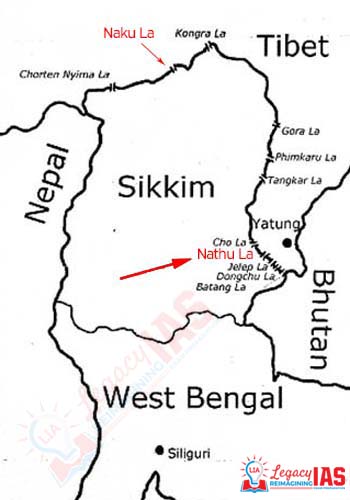
Pangong Tso
- Pangong Tso or Pangong Lake is an endorheic lake in the Himalayas situated at a height of more than 4000m.
- It is over 125 kilometres long and extends from India to the Tibetan Autonomous Region, China.
- Approximately 60% of the length of the lake lies within the Tibetan Autonomous Region.
- It is NOT a part of the Indus river basin area and geographically a separate landlocked river basin.
- The lake is in the process of being identified under the Ramsar Convention as a wetland of international importance.
Other Important Mountain Passes in North India (Himalayas)


Zoji La
- It is in the Zaskar range of Jammu & Kashmir.
- It connects Srinagar with Kargil and Leh.
- Beacon Force of Border Road Organization is responsible for clearing and maintaining the road, especially during the winter.
- It has been created by the Indus River.
Bara- Lacha Pass
- It is situated on the National Highway in the state of Jammu and Kashmir.
- It connects Manali and Leh.
Mana Pass
- It is located in the Greater Himalayas and connects Tibet with Uttarakhand.
- It remains under snow for six months during winter.
- The land route to the Kailash and the Manasarovar passes through it.
Shipki La
- The road from Shimla to Tibet goes through this pass.
- The Satluj River flows through this pass.
- It is India’s third border post for trade with China after Lipu Lekh and Nathula Pass.
Lipu Lekh
- It connects Uttarakhand with Tibet.
- This pass is an important border post for trade with China.
- The pilgrims for Manasarovar travel through this pass.
Qara Tagh Pass
- It is located in the Karakoram Mountains.
- It was a subsidiary of the ancient silk route.
Khardung La
- It is the highest motorable pass in the country.
- It connects Leh and Siachen glaciers.
- This pass remains closed during the winter.
Aghil Pass
- It is situated to the North of Mount Godwin-Austen in the Karakoram.
- It connects Ladakh with Xinjiang province of China.
- It remains closed during the winter season from November to May.
Rohtang Pass
- This is located in the state of Himachal Pradesh.
- This pass connects Kullu, Spiti, and Lahul.
- It cuts through the Pir Panjal range.
- It links Manali and Leh by road.
Jalep La
- This pass passes through the Chumbi valley.
- It connects Sikkim with Lhasa, the capital of Tibet.
- The Tista River has created this pass.
Traill’s Pass
- It is located in Uttarakhand.
- It is situated at the end of the Pindari glacier and connects the Pindari valley to Milam valley.
- This pass is very steep and rugged.
Bomdi-La
- The Bomdi-La pass connects Arunachal Pradesh with Lhasa, the capital city of Tibet.
- It is located in the east of Bhutan.
Dihang pass
- This pass connects Arunachal Pradesh with Myanmar (Mandalay).
- It amazingly provides passage at an elevation of more than 4000 m.
Banihal Pass
- Banihal pass is a popular pass in Jammu and Kashmir.
- It is situated in the Pir- Panjal Range.
- It connects Banihal with Qazigund.
-Source: The Hindu



